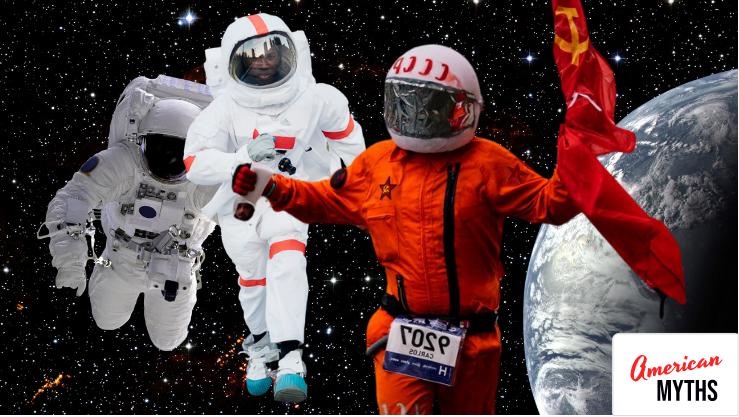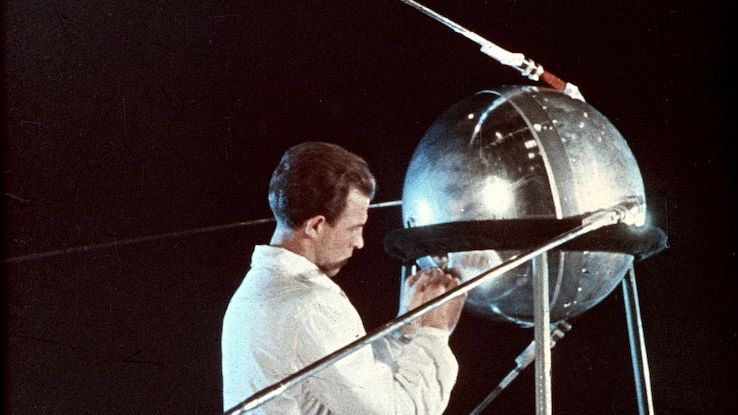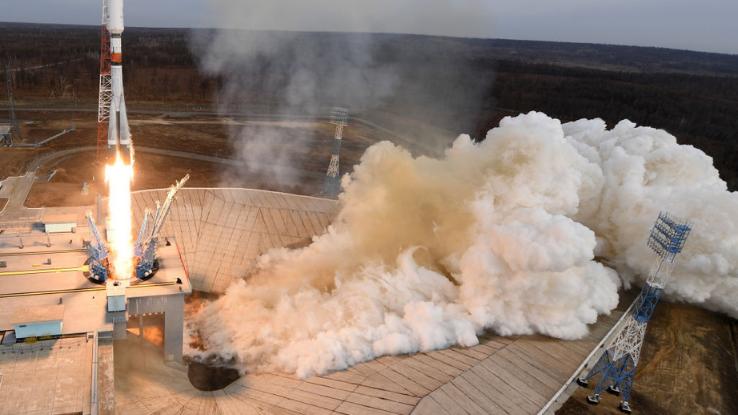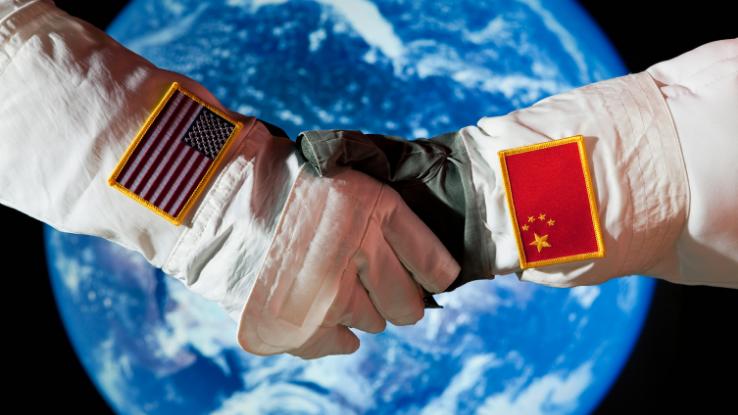Did the United States Really Win the Space Race?

Editor’s Note: This is the inaugural edition of our American Myths series in which we dispel stories from American history that are sometimes factually misrepresented and misconstrued. We’re here to get the facts right for you.
When people look back at 2021, one of the things they might remember most could be the peculiar strides in aerospace travel made by private companies and the wealthy individuals that head them up — how billionaires like Jeff Bezos, Richard Branson and Elon Musk competed against each other by launching themselves into outer space.
What jarred so many people about these interstellar pursuits, in part, was that the coronavirus pandemic was still going on. Amidst widespread illness, geopolitical conflicts, labor struggles and climate disasters, the U.S. started seeing a new “space race” unfolding before its eyes. Many were reminded of the early development of NASA and the tensions between the U.S. and Soviet Russia to see who could be the first to create various aerospace technologies.
While we know it began the 1950s, there was no official end to the Space Race. You may have been taught in school that it came to a close in 1969 when Neil Armstrong and the Apollo 11 crew walked on the moon. But that may be just one major accomplishment in a long series of ongoing milestones. Today, we’re looking at the origins of galactic travel, celebrating the allyships that can form when working together — and reviewing the multitude of breakthroughs that the Space Race’s potential winners achieved.
The Space Race’s Start

Picture it, 1955: World War II ended nearly a decade ago, Eisenhower is president, and new companies like Warner Brothers Studios and H&R Block are just opening their doors. This is the year that the Space Race began. On July 29 that year, the U.S. announced plans to build the world’s first artificial satellite. A satellite is something that rotates around a planet’s gravitational pull. An example of a natural satellite would be the moon — but the U.S.’s endeavor would be something much more advanced.
Four days after the U.S. announced its plans to launch a satellite, Russia announced the exact same thing. In a very “we both can’t wear the same dress to the party” type of way, the Space Race was underway. Space travel is just one of many fields in which the U.S. and Soviet Russia were competing against each other at the time. Because of the rivalrous Cold War, the U.S. and Soviet Russia were striving to advance their respective political and economic philosophies without engaging in active combat. Part of doing so involved demonstrating which country was more advanced — in a variety of fields that included space exploration.
The first country to get an artificial satellite orbiting Earth was Soviet Russia. On October 4, 1957, Sputnik 1 was launched, and the world looked up at the sky in awe. Sputnik 1 did induce a bit of a panic across the globe, particularly in the U.S. All anyone knew about the satellite was that it was in the sky, it could beep and it was made by Soviet Russia — a political entity Americans had been gradually led not to trust as part of larger Cold War efforts. People were panicking at the thought of being spied on and envisioned Sputnik as a weapon of sorts.
Back then, people weren’t giving personal information out the way they were today. Nor was there a 24/7 news cycle that could debunk any anxieties towards advancements in technology. Now, we may give apps permission to listen to our conversations and know our locations, but back then, people were much more defensive of that type of exchange.
Sputnik 1 did crash after three months, but it left an enduring legacy; the satellite continues to be mentioned in history books all over the world. The pressure that Soviet Russia put on the U.S. to advance in the Space Race may be what prompted Eisenhower to form NASA, the National Aeronautics and Space Administration, on July 29, 1958.
Who Really Won the Space Race?

There’s no perfect way to “keep score” in any field of rapidly advancing technology. That’s especially true when discussing the Space Race, which had the relatively ambiguous goal of seeing which country had the best space technologies and flight capabilities. But, we can shine a spotlight on a few of the major milestones reached to determine trends that pop out. In looking at the launch of the first artificial satellites — the “duel” that prompted the Space Race to begin — that’s an easy win for Soviet Russia.
How about the first mammal to venture into space? That one also goes to Soviet Russia. In 1957, Sputnik 2 was launched, and aboard that satellite was one of the most iconic animals in modern history: Laika the dog.
When it comes to the first human in space, that also goes to Soviet Russia, with Yuri Gargarin in the space capsule Vostok 1 on April 12, 1961. The first American to orbit Earth was John Glenn almost an entire year later. The first woman in space was also Russian — an honor that went to Valentina Tereshkova in August of 1964. The U.S. didn’t send a woman into space until Sally Ride’s Challenger voyage in 1983, almost 20 years later.
What about spacewalking? Aleksy Leonov of Russia was the first to walk in space. He was nearly lost in the process, but thanks to his survival in this 1965 endeavor, Leonov was able to report the massive pressure and heat he felt on his suit. Scientists used this information to make further improvements to spacesuits and spacecraft as the Space Race waged on.
The U.S. may have trailed for much of the Space Race, but once the Apollo Program really got going, the U.S. made impressive strides. The program began in 1961, but it didn’t launch a crewed mission until the Apollo 7 flight in 1968. That same year, the United States sent the first crewed flight around the Moon. Frank Borman, James Lovell and William Anders led Apollo 8 to new levels of the universe — and the Apollo Program’s success didn’t stop there. In 1969, Apollo 11’s crew made history when they landed on the moon. Neil Armstrong and Buzz Aldrin planted an American flag and played a round of golf on the natural satellite as people around the world sat glued to their radios and television sets.
Many consider this the U.S.’s way of taking control of the competition — “By landing on the moon, the United States effectively ‘won’ the space race that had begun with Sputnik’s launch in 1957,” notes History. But does that erase all of Soviet Russia’s victories early on? And does that mean that space travel doesn’t matter after the moon landing? We wouldn’t argue for either answer — or a singular winner of the race. In the end, the U.S. and Soviet Russia both saw achievements in terms of the technologies they created and the milestones they reached. Soviet Russia had the most “firsts” in space, and the U.S. attained a landmark objective in the quest for interstellar exploration.
Better Together: Space Travel Today

In 1975, tensions from the Cold War subsided somewhat when the U.S. and Soviet Russia collaborated on an astronomical mission together. Three astronauts from the U.S. and two from Soviet Russia successfully launched into space and performed experiments. This Apollo-Soyuz mission became one of modern history’s greatest collaborations.
Later, in 1998, the International Space Station (ISS) was launched. While astronauts from 18 countries have worked in the station, the U.S. and Russia remain the strongest presences there. The ISS fostered scientific breakthroughs in disease research because there are benefits to studying cells without gravity. Other discoveries aboard the ISS happened in areas like water purification and the fifth state of matter.
In 1993, China entered the Space Race with the formation of the CNSA (Chinese National Space Agency). China began building its own space station, the Tiangong Space Station, that orbits the Earth. The station is unfinished, but China has come a long way in such a short amount of time — and might also eventually embrace the collaborative spirit today’s space travel has adopted.
While so many nations have made contributions to space exploration, the Space Race is only a few strides deep into an Ironman triathlon. Everyone from Elon Musk to Mike Pence has expressed interest in getting humans to Mars, the next closest planet to Earth, but NASA does not predict a human arrival to Mars until the late 2030s. After Mars, there are more planets to explore. There are other galaxies and solar systems. Perhaps the Space Race is less about winning and more about opening up the universe for everyone.
Bottom Line: The Space Race Didn’t Have a Scoreboard or Winner

So, who really won the Space Race? It depends on who you ask. There’s no consensus on a winner, and nobody truly “won.” It’s true that the Space Race created global tension and heightened Cold War-era fears — and that there’s no way to fully define a victory in this period of history. But the end result was that the U.S. and Russia — and even China and other nations — all contributed to humanity’s greater understanding of outer space, proving that there’s no need for winners or losers here, just rockets and astronauts.





